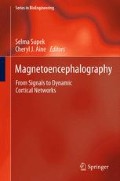Abstract
Magnetic relaxometry is a technology utilizing SQUID sensors and superparamagnetic nanoparticles to target various diseases using antibodies or other biomolecules specific to disease cells. The nanoparticles are magnetized in a small field and the SQUID sensors are used to detect the nanoparticle decaying field. The method has high sensitivity, more than 1000 times a mammogram for breast cancer, high contrast as only nanoparticles bound to cells are measured, and high specificity using specific biomarkers conjugated to the nanoparticles. Future directions of magnetic relaxometry include diagnosis of neural diseases using biomarkers specific to these diseases coupled to nanoparticles; this will complement ongoing diagnostic programs using magnetoencephalography.
Access this chapter
Tax calculation will be finalised at checkout
Purchases are for personal use only
References
Adolphi NL, Huber DL, Jaetao JE, Bryant HC, Lovato DM, Fegan DL, Venturini EL, Monson TC, Tessier TE, Hathaway HJ, Bergemann C, Larson RS, Flynn ER (2009) Characterization of magnetite nanoparticles for SQUID-relaxometry and magnetic needle biopsy. JMMM 321:1459–1464
Adolphi NL, Huber DL, Bryant HC, Monson TC, Fegan DL, Lim JK, Jaetao JE, Tessier TE, Lovato DM, Butler KS, Provencio PC, Hathaway HJ, Majetich SA, Larson RS, Flynn ER (2010) Characterization of single-core magnetite nanoparticles for magnetic imaging by SQUID-relaxometry. PMB 55:5985–6012
Adolphi NA, Butler KS, Lovato DM, Tessier TE, Trujillo JE, Hathaway HJ, Fegan DM, Monson TC, Stevens TE, Huber DL, Ramu J, Milne ML, Conradi MS, Altobelli SA, Larson RS, Flynn ER (2012a) Imaging of Her2-targeted magnetic nanoparticles for breast cancer detection, comparison of SQUID-detected magnetic relaxometry and MRI. Contrast Media Mol Imaging 7(3):308–319
Adolphi NA, Butler KS, Lovato DM, Tessier TE, Trujillo JE, Hathaway HJ, Fegan DM, Monson TC, Stevens TE, Huber DL, Ramu J, Milne ML, Conradi MS, Altobelli SA, Larson RS, Flynn ER (2012b) Imaging of Her2-targeted magnetic nanoparticles for breast cancer detection, comparison of SQUID-detected magnetic relaxometry and MRI. Contrast Media Mol Imaging 7(3):308–319
Brenner D, Williamson SJ, Kaufman L (1975) Visually evoked magnetic fields of the human brain. Science 190:480–482
Butler KS, Lovato DM, Adolphi NA, Belfon R, Fegan DM, Monson TC, Hathaway HJ, Huber DL, Tessier TE, Bryant HC, Flynn ER, Larson RS (2013) Development of antibody-tagged nanoparticles for noninvasive detection of transplant rejection using biomagnetic sensors, Cell Transplantation 22:1943–1954
Cohen D (1968) Magnetoencephalography: evidence of magnetic fields produced by alpha-rhythm currents. Science 161:784–786
Flynn ER, Bryant HC (2005) A SQUID based system for in vivo cancer imaging. Phys Med Biol 50:1273–1293
Flynn ER (1994) Factors which affect spatial resolving power in large array biomagnetic sensors. Rev Sci Inst 65:922
Flynn ER, Bryant HC, Bergemann C, Larson RS, Lovato D, Sergatskov DA (2007) Use of a SQUID array to detect T-cells with magnetic nanoparticles in determining transplant rejection. JMMM 311:429–435
Flynn ER, Adolphi NL, Bryant HC, Butler KS, Hathaway HJ, Huber DL, Lovato DM, Tessier TE, Trujillo JE, Larson RS (2014) Applications of magnetic relaxometry in ovarian cancer, to be published
Georgopoulos AP, Karageorgiou E, Leuthold AC, Lewis SM, Lynch JK, Alonso AA, Aslam Z, Carpenter AF, Georgopoulos A, Hemmy LS, Koutlas IG, Langheim FJP, McCarten JR, McPherson SE, Pardo JV, Pardo PJ, Parry GJ, Rottunda SJ, Segal BM, Sponheim SR, Stanwyck JJ, Stephane M, Westermeyer JJ (2007) Synchronous neural interactions assessed by magnetoencephalography: a functional biomarker for brain disorders. J Neural Eng 4:349–355
Georgopoulos AP, Tan HRM, Lewis SM, Leuthold AC, Winskowski AM, Lynch JK, Engdahl B (2010) The synchronous neural interactions test as a functional neuromarker for post-traumatic stress disorder (PTSD): a robust classification method based on the bootstrap. J Neural Eng 7:016011
Hämäläinen M, Hari R, Ilmoniemi RJ, Knuutila J, Lounasmaa OV (1993) Magnetoencephalography—theory, instrumentation, and applications to noninvasive studies of the working human brain. Revs Mod Phys 65:413–497
Hathaway HJ, Butler KS, Adolphi NA, Lovato DM, Belfon R, Fegan DL, Monson TC, Trujillo JE, Tessier TE, Bryant HC, Huber DL, Larson RS, Flynn ER (2011) A novel method for early detection of breast cancer using magnetic nanoparticles and ultra-sensitive magnetic field sensors. Breast Cancer Res 13:R108
Huang M, Aine CJ, Supek S, Best E, Ranken D, Flynn ER (1998) Multi-start downhill simplex methods for spatio-temporal source localization in magnetoencephalography. Electroenceph Clin Neurophys 108:32–44
Huang MX, Theilmann RJ, Robb A, Angeles A, Nichols S, Drake A, D’Andrea J, Levy M, Holland M, Song T, Sheng G, Hwang E, Yoo K, Cui L, Baker D, Trauner T, Coimbra R, Lee R (2009) Integrated imaging approach with MEG and DTI to detect mild traumatic brain injury in military and civilian patients. J Neurotrauma 26:1213–1226
Huber D (2012) Center for integrative nanotechnology, Sandia National Laboratory, private communication
Jaetao JE, Butler KS, Adolphi NL, Lovato DM, H. C. Bryant HC, Rabinowitz I, Winter SS, Tessier TE, Hathaway HJ, Bergemann C, Flynn ER, Larson RS (2009) Enhanced leukemia cell detection using a novel magnetic needle and nanoparticles. Cancer Res 69(21):8310–8316
Kötitz R (1995) Ferrofluid relaxation for biomagnetic imaging, biomagnetism: fundamental research and clinical applications. In: Baumgartner C et al (eds) Elsevier science. IOS Press, Amsterdam, p 785
Néel L (1955) Some theoretical aspects of rock-magnetism. Adv Phys 4:191–243
Romanus E, Huckel M, Gross C, Prass S, Brauer R, Weitsches W, Weber P (2001) Magnetic nanoparticles as a novel tool in vivo diagnostics, ICMF9 MRX poster
Supek S, Aine C, Ranken D, Best E, Flynn ER, Wood C (1999) Single versus paired visual stimulation: superposition of early neuromagnetic responses and retinotopy in exstrastriate cortex in humans. Brain Res 830:43–55
Zimmerman JE (1966) Macroscopic quantum interference effects through superconducting point contacts. Phys Rev 141:367–375
Author information
Authors and Affiliations
Corresponding author
Editor information
Editors and Affiliations
Rights and permissions
Copyright information
© 2014 Springer-Verlag Berlin Heidelberg
About this chapter
Cite this chapter
Flynn, E.R. (2014). Magnetic Relaxometry: A Comparison to Magnetoencephalography. In: Supek, S., Aine, C. (eds) Magnetoencephalography. Springer, Berlin, Heidelberg. https://doi.org/10.1007/978-3-642-33045-2_48
Download citation
DOI: https://doi.org/10.1007/978-3-642-33045-2_48
Published:
Publisher Name: Springer, Berlin, Heidelberg
Print ISBN: 978-3-642-33044-5
Online ISBN: 978-3-642-33045-2
eBook Packages: EngineeringEngineering (R0)

